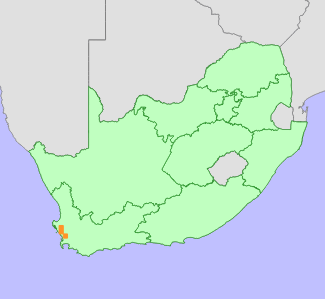|
Scientific Name | Lachenalia purpureo-caerulea Jacq. |
Higher Classification | Monocotyledons |
Family | HYACINTHACEAE |
Synonyms | Lachenalia botryoides Tratt. |
National Status |
Status and Criteria | Critically Endangered B1ab(iii,v) |
Assessment Date | 2020/03/17 |
Assessor(s) | H. Mtshali, D. Raimondo & G.D. Duncan |
Justification | Lachenalia purpureo-caerulea has a restricted distribution range, with an extent of occurrence (EOO) of 7-63 km², and an area of occupancy (AOO) of 8-12 km². Two small, severely fragmented subpopulations continue to decline due to ongoing habitat degradation, as well as competition from alien invasive plants. |
Distribution |
Endemism | South African endemic |
Provincial distribution | Western Cape |
Range | This species is endemic to a small area in the Western Cape's coastal lowlands, where it occurs between Darling, Mamre and Malmesbury. |
Habitat and Ecology |
Major system | Terrestrial |
Major habitats | Saldanha Flats Strandveld, Swartland Granite Renosterveld |
Description | It occurs in seasonally moist or waterlogged gravelly flats in granite renosterveld. Mature fruits split open and the seeds are dispersed locally. The sweet-scented flowers are pollinated by honey bees. It needs winter rains and summer drought for its survival. |
Threats |
| About 80% of this species' habitat is already irreversibly modified, predominantly due to historical loss to agricultural expansion. It has also possibly declined due to urban expansion around Darling and Mamre.
Remaining subpopulations occur on isolated fragments, where they are threatened by competition from alien invasive plants, particularly grasses, inappropriate fire management, and overgrazing by livestock. Small fragments surrounded by crop fields are also subjected to the negative impacts of herbicide and pesticide drift, and eutrophication and pollution from fertilizer runoff. |
Population |
This species historically had a very restricted distribution, with an extent of occurrence (EOO) of 249 km², but through habitat loss and degradation, the EOO has been reduced by 75-97%. Two subpopulations known through historical records are now locally extinct, and a third, in a small municipal reserve on the outskirts of Darling was last recorded in the 1960s. This reserve has been repeatedly surveyed for threatened plant species since 2003, and the population has not been recorded, and is likely locally extinct. Recent field surveys confirmed the existence of only two small, isolated subpopulations, making the population severely fragmented. The largest subpopulation consists of 100-250 plants, while the second, smaller subpopulation has 70-200 plants. A continuing decline is inferred from ongoing habitat loss and degradation.
|
Population trend | Decreasing |
Assessment History |
Taxon assessed |
Status and Criteria |
Citation/Red List version | | Lachenalia purpureo-caerulea Jacq. | CR B1ab(iii)+2ab(iii) | Raimondo et al. (2009) | | Lachenalia purpureo-caerulea Jacq. | Endangered | Hilton-Taylor (1996) | | Lachenalia purpureo-caerulea Jacq. | Endangered | Hall et al. (1980) | |
Bibliography |
Duncan, G.D. 1988. Lachenalia handbook. Annals of Kirstenbosch Botanic Garden 17:1-71.
Duncan, G.D. 2012. The genus Lachenalia. Kew Publishing, Royal Botanic Gardens, Kew.
Goldblatt, P. and Manning, J.C. 2000. Cape Plants: A conspectus of the Cape Flora of South Africa. Strelitzia 9. National Botanical Institute, Cape Town.
Hall, A.V., De Winter, M., De Winter, B. and Van Oosterhout, S.A.M. 1980. Threatened plants of southern Africa. South African National Scienctific Programmes Report 45. CSIR, Pretoria.
Hilton-Taylor, C. 1996. Red data list of southern African plants. Strelitzia 4. South African National Botanical Institute, Pretoria.
Raimondo, D., von Staden, L., Foden, W., Victor, J.E., Helme, N.A., Turner, R.C., Kamundi, D.A. and Manyama, P.A. 2009. Red List of South African Plants. Strelitzia 25. South African National Biodiversity Institute, Pretoria.
|
Citation |
| Mtshali, H., Raimondo, D. & Duncan, G.D. 2020. Lachenalia purpureo-caerulea Jacq. National Assessment: Red List of South African Plants version 2024.1. Accessed on 2025/11/15 |
 Comment on this assessment
Comment on this assessment


